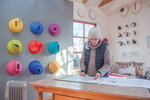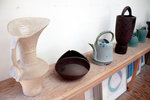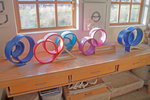Nothing in Anne Hirondelle’s background would seem to have led to her life as an artist.
By her own account, she grew up on a farm “knowing nothing about art,” and her studies …
This item is available in full to subscribers.
We have recently launched a new and improved website. To continue reading, you will need to either log into your subscriber account, or purchase a new subscription.
If you had an active account on our previous website, then you have an account here. Simply reset your password to regain access to your account.
If you did not have an account on our previous website, but are a current print subscriber, click here to set up your website account.
Otherwise, click here to view your options for subscribing.
* Having trouble? Call our circulation department at 360-385-2900, or email our support.
Please log in to continue |
|



Nothing in Anne Hirondelle’s background would seem to have led to her life as an artist.
By her own account, she grew up on a farm “knowing nothing about art,” and her studies were devoted to social justice, a vocation she found fulfilling and still takes pride in having done.
After getting her master’s degree in counseling from Stanford University, Hirondelle directed a feminist social agency in Seattle for five years, making available a women’s health clinic, an auto mechanic shop for women and services for lesbian clients, all at a time when abortion was still illegal in Washington state.
“Then, I went to law school, which was the biggest mistake of my life,” Hirondelle said. “My work before had been satisfying and important, and I thought I could continue that through the legal profession. I wound up being miserable for a year before I could work up the courage to leave, since I’d never quit at anything before.”
Seeking to pursue interests that “didn’t have anything to do with the law,” Hirondelle attended “a pottery class at a local art school,” quickly hopscotched from the ceramics program at the Factory of Visual Arts in Seattle to the Bachelor of Fine Arts program at the University of Washington.
“I wasn’t interested in getting any more degrees,” Hirondelle said. “At first, I had no idea what I wanted to do, besides just make my pots.”
With no previous background in art, Hirondelle found herself inspired by the works of Robert Sperry, an influential ceramic artist who was on the faculty of the University of Washington from 1955 until his retirement in 1982, serving as the head of the ceramics department for 22 years.
“And during the weekends, I would go to the galleries at Pioneer Square and look at the clay and ceramic vessels for hours,” Hirondelle said. “There’s a power to certain clay sculptures that I can’t describe. I just know it when I see it.”
Given the variety of laborious jobs that Hirondelle had to do on her family farm as she was growing up, she suspects that the physicality of working with clay also appealed to her.
Hirondelle and her husband came to Port Townsend in 1977, where she’s lived and worked ever since, her current studio hidden away behind a rustic exterior that’s far less avant-garde than its contents.
For more than 20 years, Hirondelle was drawn to the vessel as her template, including the early teapot forms that put her on the cover of Ceramics Monthly in the early 1980s. She employed vessels as starting points for her abstraction, as well as metaphors for containment, taking ideas from traditional functional pots and extending them into architectural and organic sculptural forms.
Hirondelle cited her period of firing her sculptures in “a huge walk-in kiln” during the 1990s as but one example of her evolution as an artist.
“Before too long, I felt worn out, and my ideas were wearing out,” Hirondelle said. “I wanted to be able to work for another 20 years, so I bought an electric kiln and I gave up glazing. Not having to worry about glazing freed me to think of my pieces as sculptures.”
A knock-on effect of abandoning glazing was that Hirondelle could begin to experiment with color, an element she hadn’t used before.
The late 1990s saw Hirondelle embracing another new challenge, as she began drawing in addition to sculpting, and while her drawings have been even more abstract than many of her sculptures, she attributes their origins to a relatively simple inspiration.
“Virtually all of my early sculptures started at the pottery wheel, and I wanted to remain true to that, which is why all my drawings involve circles and squares,” Hirondelle said. “And even when I’m drawing in two dimensions, it’s adapted from three dimensions after I’ve sculpted it in clay. The sculptures tell me what to draw. Other artists use drawings as sketches for their sculptures, but I use sculptures as sketches for my drawings.”
Hirondelle draws with graphite and colored pencils on multiple layers of tracing paper, which she pointed out makes even her two-dimensional art technically three-dimensional.
After more than four decades as a Port Townsend artist, Hirondelle was still humbled when Shelly Leavens, executive director of the Jefferson County Historical Society, suggested displaying her work in the Jefferson Museum of Art and History.
Not only will the museum exhibit Hirondelle’s work from Friday, March 6, through Monday, June 22, but Jefferson County Historical Society members will receive a preview of the exhibition from 5 to 7 p.m. on Thursday, March 5.
Hirondelle will also be available from 5 to 6:30 p.m. on Thursday, March 26, for an artist’s talk on “My Journey in Clay,” in the Ferguson Gallery at the Jefferson Museum of Art & History, as well as from 5:30 to 8 p.m. during the First Saturday Art Walk of April 4 for a book reading of “Straight Art” at the Jefferson Museum of Art and History.